MITSUBISHI MIRAGE G4 2020 Owner's Manual (in English)
Manufacturer: MITSUBISHI, Model Year: 2020, Model line: MIRAGE G4, Model: MITSUBISHI MIRAGE G4 2020Pages: 253, PDF Size: 36.39 MB
Page 201 of 253
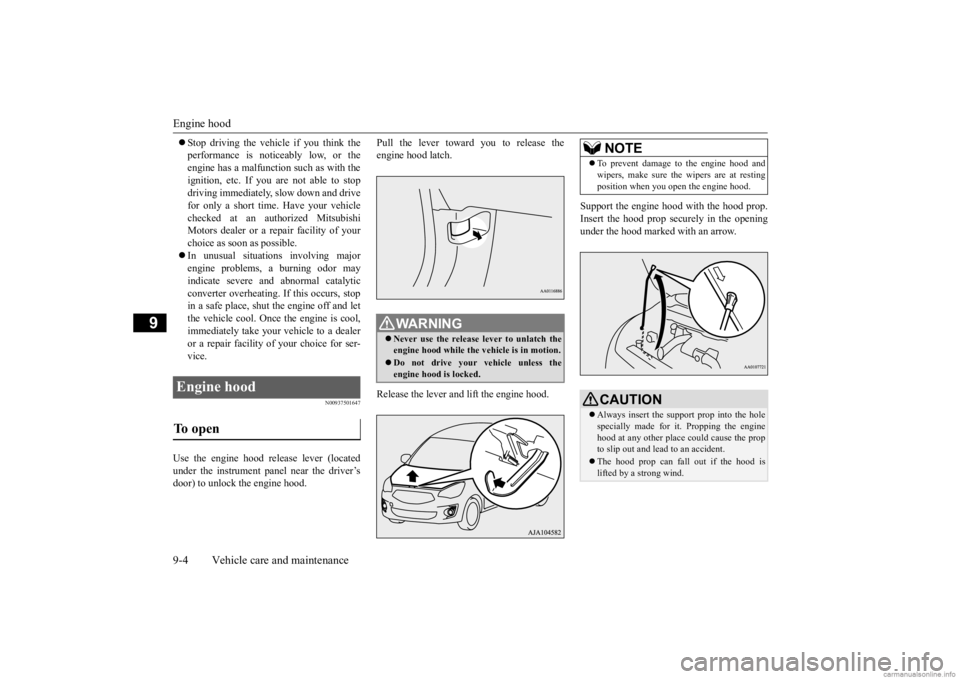
Engine hood 9-4 Vehicle care and maintenance
9
Stop driving the vehicle if you think the performance is noticeably low, or theengine has a malfunction such as with the ignition, etc. If you are not able to stop driving immediately,
slow down and drive
for only a short time. Have your vehicle checked at an authorized Mitsubishi Motors dealer or a repair facility of yourchoice as soon
as possible.
In unusual situations involving major engine problems, a burning odor may indicate severe a
nd abnormal catalytic
converter overheating.
If this occurs, stop
in a safe place, shut
the engine off and let
the vehicle cool. Once the engine is cool, immediately take your
vehicle to a dealer
or a repair facility of your choice for ser- vice.
N00937501647
Use the engine hood re
lease lever (located
under the instrument panel near the driver’s door) to unlock the engine hood.
Pull the lever toward you to release the engine hood latch. Release the lever and
lift the engine hood.
Support the engine hood with the hood prop. Insert the hood prop securely in the opening under the hood marked with an arrow.
Engine hood To open
WA R N I N G Never use the release lever to unlatch the engine hood while the
vehicle is in motion.
Do not drive your vehicle unless the engine hood is locked.
NOTE
To prevent damage to the engine hood and wipers, make sure the
wipers are at resting
position when you open the engine hood.CAUTION Always insert the support prop into the hole specially made for
it. Propping the engine
hood at any other place could cause the propto slip out and lead to an accident. The hood prop can fall out if the hood is lifted by a strong wind.
BK0284300US.book 4 ページ 2019年5月23日 木曜日 午後12時22分
Page 202 of 253
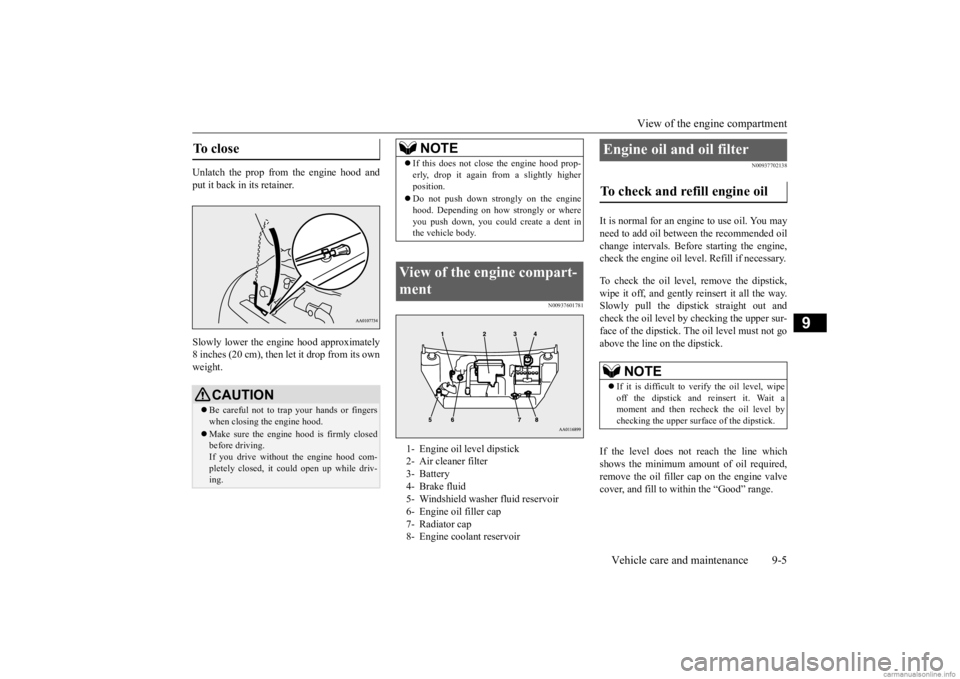
View of the engine compartment
Vehicle care and maintenance 9-5
9
Unlatch the prop from the engine hood and put it back in its retainer. Slowly lower the engi
ne hood approximately
8 inches (20 cm), then let it drop from its own weight.
N00937601781
N00937702138
It is normal for an engi
ne to use oil. You may
need to add oil betwee
n the recommended oil
change intervals. Before starting the engine,check the engine oil level. Refill if necessary. To check the oil level, remove the dipstick, wipe it off, and gently
reinsert it all the way.
Slowly pull the dipsti
ck straight out and
check the oil level by checking the upper sur- face of the dipstick. Th
e oil level must not go
above the line on the dipstick. If the level does not reach the line which shows the minimum amo
unt of oil required,
remove the oil filler cap on the engine valve cover, and fill to within the “Good” range.
To close
CAUTION Be careful not to trap your hands or fingers when closing the engine hood. Make sure the engine hood is firmly closed before driving.If you drive without the engine hood com- pletely closed, it c
ould open up while driv-
ing.
NOTE
If this does not clos
e the engine hood prop-
erly, drop it again from a slightly higherposition. Do not push down strongly on the engine hood. Depending on how strongly or whereyou push down, you could create a dent in the vehicle body.
View of the engine compart- ment 1- Engine oil level dipstick 2- Air cleaner filter 3- Battery 4- Brake fluid5- Windshield washer fluid reservoir 6- Engine oil filler cap 7- Radiator cap8- Engine cool
ant reservoir
Engine oil and oil filter To check and refill engine oil
NOTE
If it is difficult to verify the oil level, wipe off the dipstick and
reinsert it. Wait a
moment and then recheck the oil level by checking the upper surfa
ce of the dipstick.
BK0284300US.book 5 ページ 2019年5月23日 木曜日 午後12時22分
Page 203 of 253
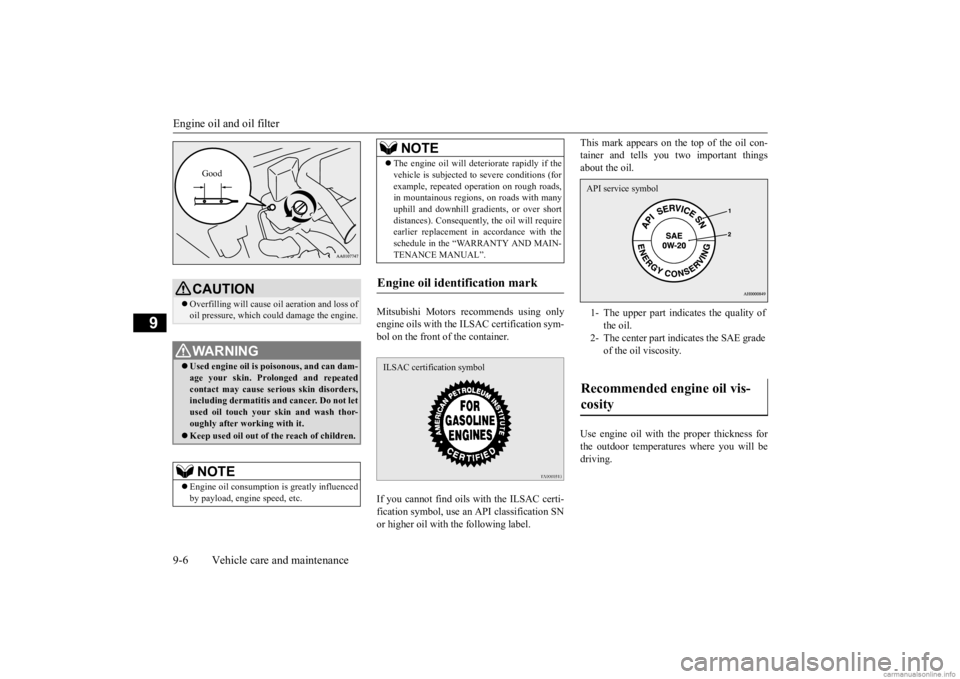
Engine oil and oil filter 9-6 Vehicle care and maintenance
9
Mitsubishi Motors recommends using only engine oils with the ILSAC certification sym- bol on the front of the container. If you cannot find oils
with the ILSAC certi-
fication symbol, use an API classification SN or higher oil with the following label.
This mark appears on the top of the oil con- tainer and tells you two important thingsabout the oil. Use engine oil with the proper thickness for the outdoor temperatures where you will bedriving.
CAUTION Overfilling will cause oil aeration and loss of oil pressure, which coul
d damage the engine.
WA R N I N GUsed engine oil is po
isonous, and can dam-
age your skin. Prolonged and repeatedcontact may cause serious skin disorders, including dermatitis and cancer. Do not let used oil touch your sk
in and wash thor-
oughly after working with it. Keep used oil out of
the reach of children.
NOTE
Engine oil consumption
is greatly influenced
by payload, engine speed, etc.
Good
The engine oil wi
ll deteriorate rapidly if the
vehicle is subj
ected to severe conditions (for
example, repeated operation on rough roads,in mountainous regions, on roads with many uphill and downhill gradients, or over short distances). Consequently
, the oil will require
earlier replacement in accordance with the schedule in the “WARRANTY AND MAIN- TENANCE MANUAL”.
Engine oil identification mark
NOTE
ILSAC certification symbol
1- The upper part indicates the quality of
the oil.
2- The center part i
ndicates the SAE grade
of the oil viscosity.
Recommended engine oil vis- cosity API service symbol
BK0284300US.book 6 ページ 2019年5月23日 木曜日 午後12時22分
Page 204 of 253
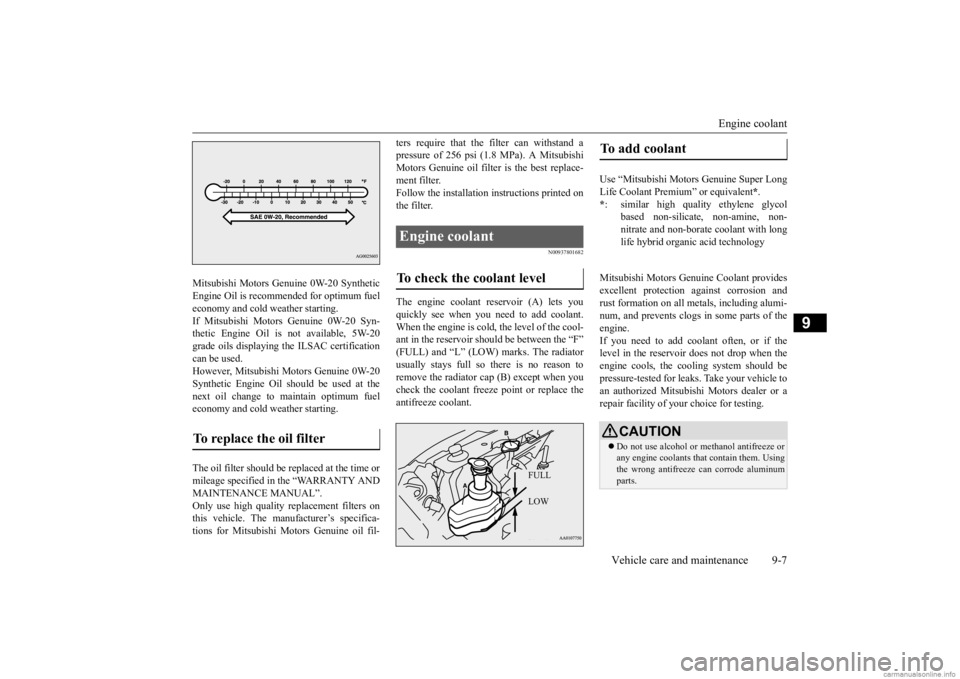
Engine coolant
Vehicle care and maintenance 9-7
9
Mitsubishi Motors Genui
ne 0W-20 Synthetic
Engine Oil is recommended for optimum fueleconomy and cold weather starting. If Mitsubishi Motors Genuine 0W-20 Syn- thetic Engine Oil is not available, 5W-20grade oils displaying th
e ILSAC certification
can be used. However, Mitsubishi Motors Genuine 0W-20Synthetic Engine Oil s
hould be used at the
next oil change to maintain optimum fuel economy and cold weather starting. The oil filter should be replaced at the time or mileage specified in the “WARRANTY ANDMAINTENANCE MANUAL”. Only use high quality
replacement filters on
this vehicle. The manufacturer’s specifica-tions for Mitsubishi Mo
tors Genuine oil fil-
ters require that the filter can withstand a pressure of 256 psi (1.8 MPa). A MitsubishiMotors Genuine oil filter
is the best replace-
ment filter. Follow the installation instructions printed onthe filter.
N00937801682
The engine coolant reservoir (A) lets youquickly see when you need to add coolant. When the engine is cold
, the level of the cool-
ant in the reservoir should be between the “F”(FULL) and “L” (LOW) marks. The radiator usually stays full so there is no reason to remove the radiator cap (B) except when youcheck the coolant freeze point or replace the antifreeze coolant.
Mitsubishi Motors Genuine Coolant provides excellent protection
against corrosion and
rust formation on all me
tals, including alumi-
num, and prevents clogs in some parts of theengine. If you need to add coolant often, or if the level in the reservoir does not drop when theengine cools, the c
ooling system should be
pressure-tested for leaks. Take your vehicle to an authorized Mitsubishi Motors dealer or arepair facility of your
choice for testing.
To replace the oil filter
Engine coolant To check the coolant level
FULL LOW
To add coolant Use “Mitsubishi Motors
Genuine Super Long
Life Coolant Premium” or equivalent
*.
* : similar high quality
ethylene glycol
based non-silicate
, non-amine, non-
nitrate and non-borate coolant with long life hybrid organic acid technologyCAUTION Do not use alcohol or
methanol antifreeze or
any engine coolants th
at contain them. Using
the wrong antifreeze can corrode aluminum parts.
BK0284300US.book 7 ページ 2019年5月23日 木曜日 午後12時22分
Page 205 of 253
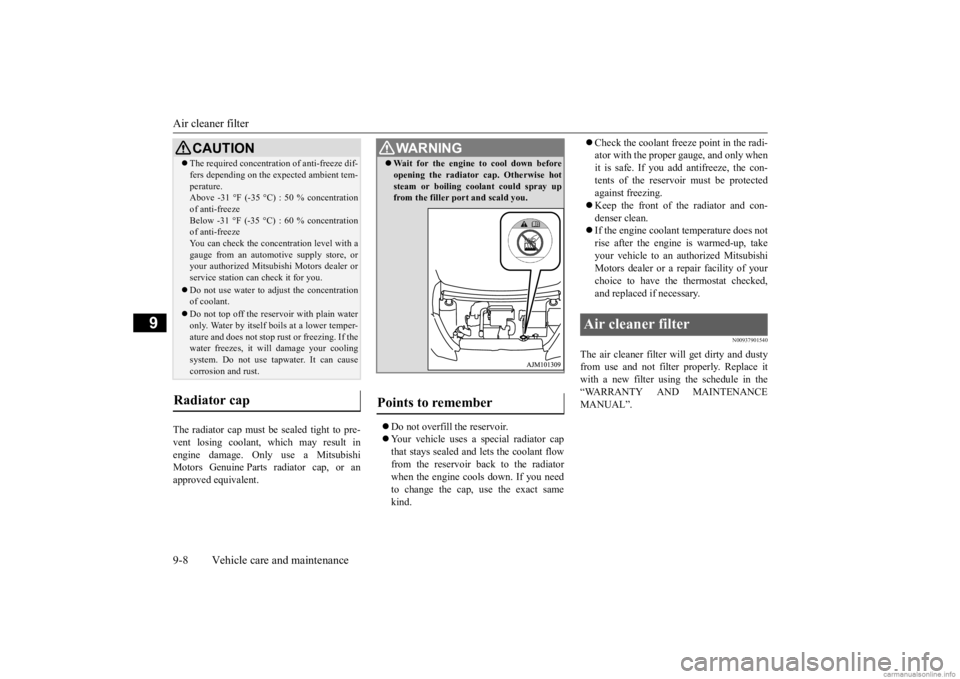
Air cleaner filter 9-8 Vehicle care and maintenance
9
The radiator cap must be
sealed tight to pre-
vent losing coolant, which may result in engine damage. Only use a Mitsubishi Motors Genuine Parts radiator cap, or anapproved equivalent.
Do not overfill the reservoir. Your vehicle uses a special radiator cap that stays sealed and lets the coolant flow from the reservoir back to the radiatorwhen the engine cools down. If you need to change the cap, use the exact same kind.
Check the coolant freeze point in the radi- ator with the proper gauge, and only whenit is safe. If you add antifreeze, the con- tents of the reservoi
r must be protected
against freezing. Keep the front of the radiator and con- denser clean. If the engine coolan
t temperature does not
rise after the engine
is warmed-up, take
your vehicle to an au
thorized Mitsubishi
Motors dealer or a repair facility of your choice to have the thermostat checked, and replaced if necessary.
N00937901540
The air cleaner filter
will get dirty and dusty
from use and not filter
properly. Replace it
with a new filter using the schedule in the “WARRANTY AND MAINTENANCE MANUAL”.
The required concentrati
on of anti-freeze dif-
fers depending on the
expected ambient tem-
perature.Above -31 °F (-35 °C) : 50 % concentration of anti-freeze Below -31 °F (-35 °C) : 60 % concentrationof anti-freeze You can check the concentration level with a gauge from an automotive supply store, oryour authorized Mitsubi
shi Motors dealer or
service station can check it for you. Do not use water to adjust the concentration of coolant. Do not top off the reservoir with plain water only. Water by itself bo
ils at a lower temper-
ature and does not stop rust or freezing. If thewater freezes, it will
damage your cooling
system. Do not use tapwater. It can cause corrosion and rust.
Radiator cap
CAUTION
WA R N I N G Wait for the engine to cool down before opening the radiator
cap. Otherwise hot
steam or boiling c
oolant could spray up
from the filler po
rt and scald you.
Points to remember
Air cleaner filter
BK0284300US.book 8 ページ 2019年5月23日 木曜日 午後12時22分
Page 206 of 253
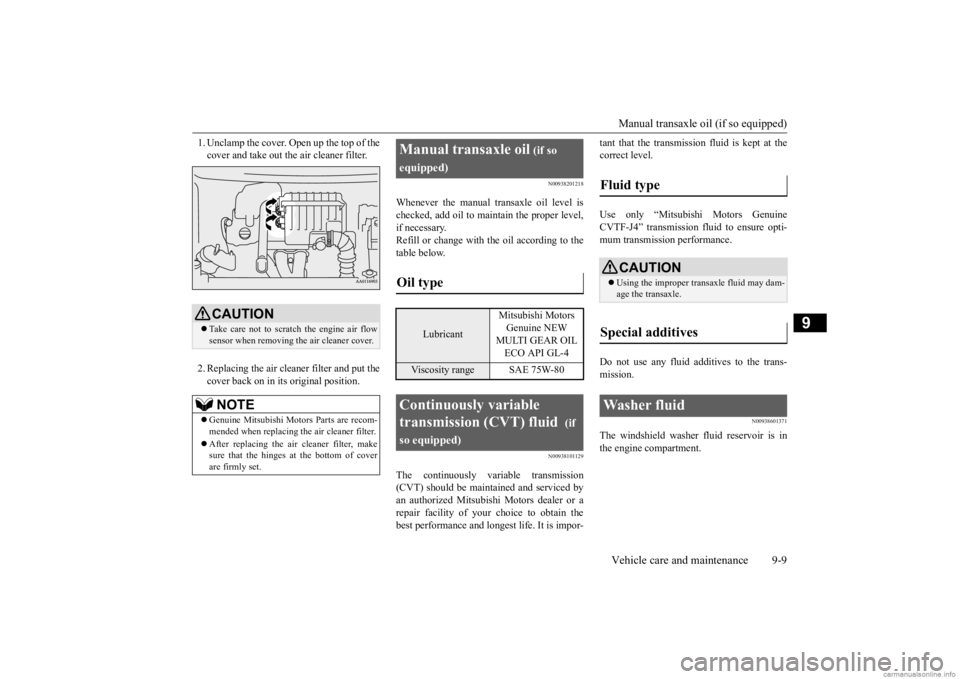
Manual transaxle oil (if so equipped) Vehicle care and maintenance 9-9
9
1. Unclamp the cover. Open up the top of the cover and take out th
e air cleaner filter.
2. Replacing the air clea
ner filter and put the
cover back on in its original position.
N00938201218
Whenever the manual transaxle oil level ischecked, add oil to maintain the proper level,if necessary. Refill or change with the oil according to the table below.
N00938101129
The continuously variable transmission(CVT) should be maintained and serviced byan authorized Mitsubishi Motors dealer or a repair facility of your choice to obtain the best performance and longest life. It is impor-
tant that the transmission fluid is kept at the correct level. Use only “Mitsubish
i Motors Genuine
CVTF-J4” transmission fluid to ensure opti-mum transmission performance. Do not use any fluid additives to the trans- mission.
N00938601371
The windshield washer
fluid reservoir is in
the engine compartment.
CAUTION Take care not to scra
tch the engine air flow
sensor when removing
the air cleaner cover.
NOTE
Genuine Mitsubishi Moto
rs Parts are recom-
mended when replacing th
e air cleaner filter.
After replacing the air cleaner filter, make sure that the hinges at the bottom of cover are firmly set.
Manual transaxle oil
(if so
equipped)Oil type
Lubricant
Mitsubishi Motors Genuine NEW MULTI GEAR OIL ECO API GL-4
Viscosity range SAE 75W-80
Continuously variable transmission (CVT) fluid
(if
so equipped)
Fluid type
CAUTION Using the improper transaxle fluid may dam- age the transaxle.
Special additives
Washer fluid
BK0284300US.book 9 ページ 2019年5月23日 木曜日 午後12時22分
Page 207 of 253
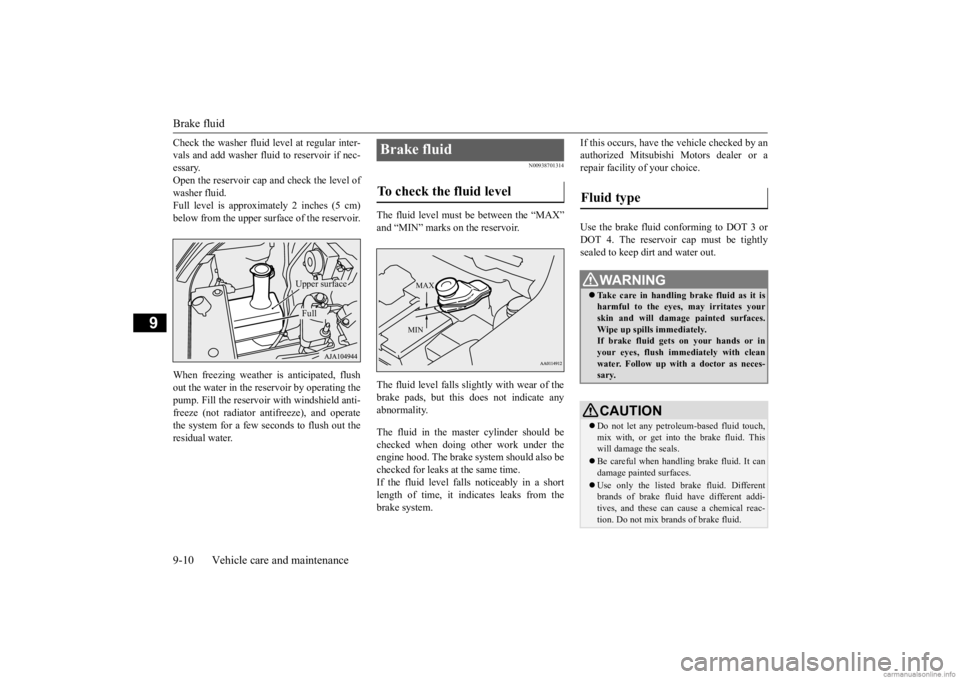
Brake fluid 9-10 Vehicle care and maintenance
9
Check the washer fluid
level at regular inter-
vals and add washer fluid to reservoir if nec-essary. Open the reservoir cap and check the level of washer fluid.Full level is approximately 2 inches (5 cm) below from the upper surface of the reservoir. When freezing weather is anticipated, flush out the water in the reservoir by operating the pump. Fill the reservoir with windshield anti-freeze (not radiator an
tifreeze), and operate
the system for a few seconds to flush out the residual water.
N00938701314
The fluid level must be between the “MAX”and “MIN” marks on the reservoir. The fluid level falls slightly with wear of the brake pads, but this
does not indicate any
abnormality. The fluid in the master cylinder should be checked when doing other work under theengine hood. The brake system should also be checked for leaks at the same time. If the fluid level falls
noticeably in a short
length of time, it indi
cates leaks from the
brake system.
If this occurs, have the vehicle checked by an authorized Mitsubishi Motors dealer or arepair facility of your choice. Use the brake fluid conforming to DOT 3 or DOT 4. The reservoir cap must be tightly sealed to keep dirt and water out.
Upper surface Full
Brake fluid To check the fluid level
MAX MIN
Fluid type
WA R N I N G Take care in handling brake fluid as it is harmful to the eyes, may irritates your skin and will damage
painted surfaces.
Wipe up spills immediately. If brake fluid gets on your hands or in your eyes, flush immediately with cleanwater. Follow up with a doctor as neces- sary.CAUTION Do not let any petrol
eum-based fluid touch,
mix with, or get into
the brake fluid. This
will damage the seals. Be careful when handli
ng brake fluid. It can
damage painted surfaces. Use only the listed brake fluid. Different brands of brake fluid
have different addi-
tives, and these can cause a chemical reac- tion. Do not mix brands of brake fluid.
BK0284300US.book 10 ページ 2019年5月23日 木曜日 午後12時22分
Page 208 of 253
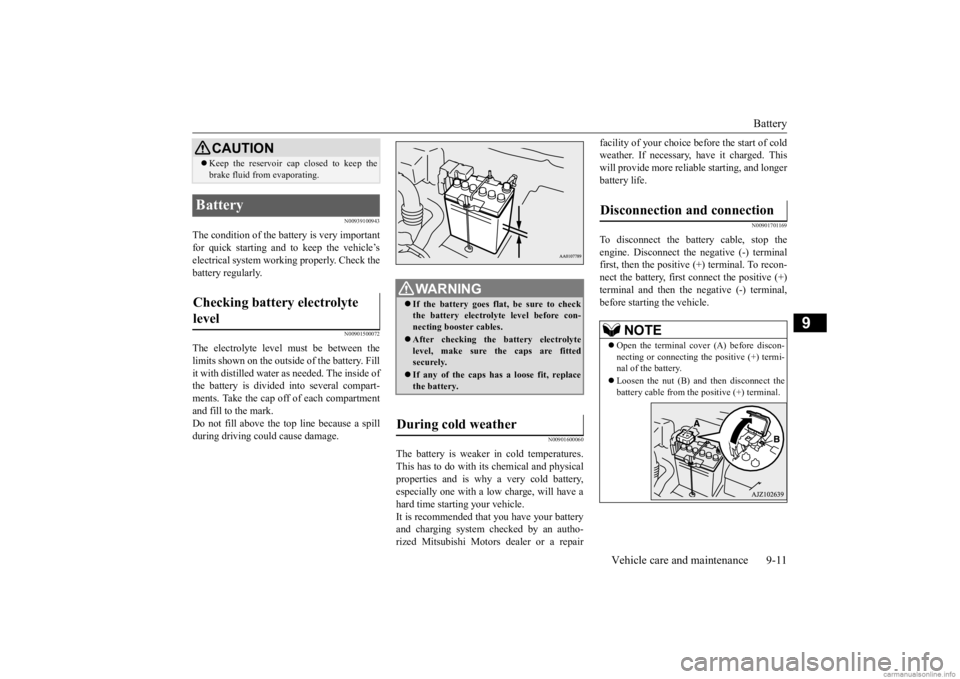
Battery
Vehicle care and maintenance 9-11
9
N00939100943
The condition of the batte
ry is very important
for quick starting and to keep the vehicle’s electrical system working properly. Check thebattery regularly.
N00901500072
The electrolyte level
must be between the
limits shown on the outside of the battery. Fill it with distilled water as needed. The inside ofthe battery is divided into several compart- ments. Take the cap off of each compartment and fill to the mark.Do not fill above the top line because a spill during driving could cause damage.
N00901600060
The battery is weaker in cold temperatures. This has to do with its chemical and physical properties and is why a very cold battery, especially one with a lo
w charge, will have a
hard time starting your vehicle. It is recommended that you have your battery and charging system checked by an autho-rized Mitsubishi Motors dealer or a repair
facility of your choice
before the start of cold
weather. If necessary, have it charged. Thiswill provide more reliab
le starting, and longer
battery life.
N00901701169
To disconnect the battery cable, stop theengine. Disconne
ct the negative (-) terminal
first, then the positive
(+) terminal. To recon-
nect the battery, first
connect the positive (+)
terminal and then the negative (-) terminal,before starting the vehicle.
Keep the reservoir cap closed to keep the brake fluid from evaporating.
Battery Checking battery electrolyte level
CAUTION
WA R N I N G If the battery goes flat, be sure to check the battery electrolyte level before con-necting booster cables. After checking the battery electrolyte level, make sure the caps are fitted securely. If any of the caps has a loose fit, replace the battery.
During cold weather
Disconnection and connection
NOTE
Open the terminal cover (A) before discon- necting or connecting the positive (+) termi- nal of the battery. Loosen the nut (B) and then disconnect the battery cable from the positive (+) terminal.
BK0284300US.book 11 ページ 2019年5月23日 木曜日 午後12時22分
Page 209 of 253
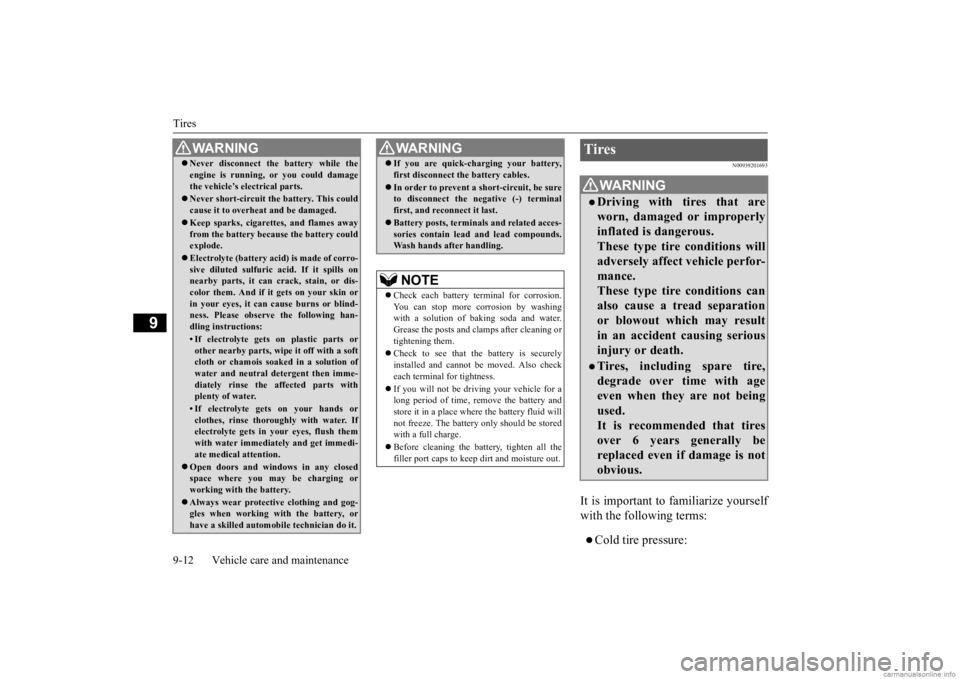
Tires 9-12 Vehicle care and maintenance
9
N00939201693
It is important to familiarize yourself with the following terms:Cold tire pressure:
WA R N I N G Never disconnect the battery while the engine is running, or you could damagethe vehicle’s electrical parts. Never short-circuit the battery. This could cause it to overheat and be damaged. Keep sparks, cigarette
s, and flames away
from the battery because the battery couldexplode. Electrolyte (battery acid) is made of corro- sive diluted sulfuric acid. If it spills on nearby parts, it can crack, stain, or dis- color them. And if it gets on your skin orin your eyes, it can cause burns or blind- ness. Please observe the following han- dling instructions:• If electrolyte gets on plastic parts orother nearby parts, wipe it off with a softcloth or chamois soak
ed in a solution of
water and neutral detergent then imme- diately rinse the affected parts withplenty of water.• If electrolyte gets on your hands orclothes, rinse thoroughly with water. If electrolyte gets in
your eyes, flush them
with water immediately and get immedi-ate medical attention.
Open doors and wind
ows in any closed
space where you may be charging or working with the battery. Always wear protective clothing and gog- gles when working with the battery, or have a skilled automobi
le technician do it.
If you are quick-charging your battery, first disconnect the battery cables. In order to prevent a short-circuit, be sure to disconnect the negative (-) terminal first, and reconnect it last. Battery posts, termin
als and related acces-
sories contain lead
and lead compounds.
Wash hands after handling.NOTE
Check each battery terminal for corrosion. You can stop more corrosion by washing with a solution of baking soda and water. Grease the posts and cl
amps after cleaning or
tightening them. Check to see that the battery is securely installed and cannot be
moved. Also check
each terminal for tightness. If you will not be driv
ing your vehicle for a
long period of time, re
move the battery and
store it in a place where the battery fluid willnot freeze. The batter
y only should be stored
with a full charge. Before cleaning the ba
ttery, tighten all the
filler port caps to keep
dirt and moisture out.
WA R N I N G
Tires
WA R N I N GDriving with tires that are worn, damaged or improperly inflated is dangerous.These type tire
conditions will
adversely affect vehicle perfor- mance.These type tire conditions can also cause a tread separation or blowout which may resultin an accident causing serious injury or death.Tires, including spare tire,degrade over time with age even when they are not beingused. It is recommended that tires over 6 years generally bereplaced even if damage is not obvious.
BK0284300US.book 12 ページ 2019年5月23日 木曜日 午後12時22分
Page 210 of 253

Tires
Vehicle care and maintenance 9-13
9
•The measured pressure after the vehicle has been parked for at least three hours, or•The measured pressure when the vehicle is driven less than 1 mile (1.6 km) after having beenparked for three hours.
Maximum pressure: the maximumpermissible cold tire inflationpressure for this tire.Recommended inflation pressure:the inflation pressure for optimumtire performance.Intended outboard sidewall:•The sidewall that contains awhitewall, bears white lettering or bears manufacturer, brand, and/or model name molding thatis higher or deeper than the same molding on the other sidewall of the tire,or
•The outward facing sidewall ofan asymmetrical tire that has a particular side that must always face outward when mounted on avehicle.
Passenger car tire: a tire intendedfor use on passenger cars, multi-purpose passenger vehicles, and trucks that have a gross vehicle weight rating (GVWR) of 10,000pounds or less.Light truck (LT) tire: a tire desig-nated by its manufacturer as pri-marily intended for use on lightweight trucks or multipurpose passenger vehicles.Tread: portion of a tire that comes into contact with the road.Tread rib: a tread section running circumferentially around a tire.Tread separation: pulling away ofthe tread from the tire carcass.Carcass: the tire structure, excepttread and sidewall rubber which, when inflated, bears the load.Sidewall: portion of a tire between the tread and bead.
Section width: the linear distancebetween the exteriors of the side- walls of an inflated tire, excluding elevations due to labeling, decora-tion, or protective bands.Bead: the part of the tire that ismade of steel wires, wrapped orreinforced by ply cords and that is shaped to fit the rim.Ply: a layer of rubber-coated par- allel cords.Cord: the strands
forming the plies
in the tire.Rim: a metal support for a tire or a tire and tube assembly upon which the tire beads are seated.Rim diameter: nominal diameter of the bead seat.Groove: the space between two adjacent tread ribs.
BK0284300US.book 13 ページ 2019年5月23日 木曜日 午後12時22分